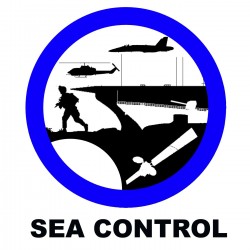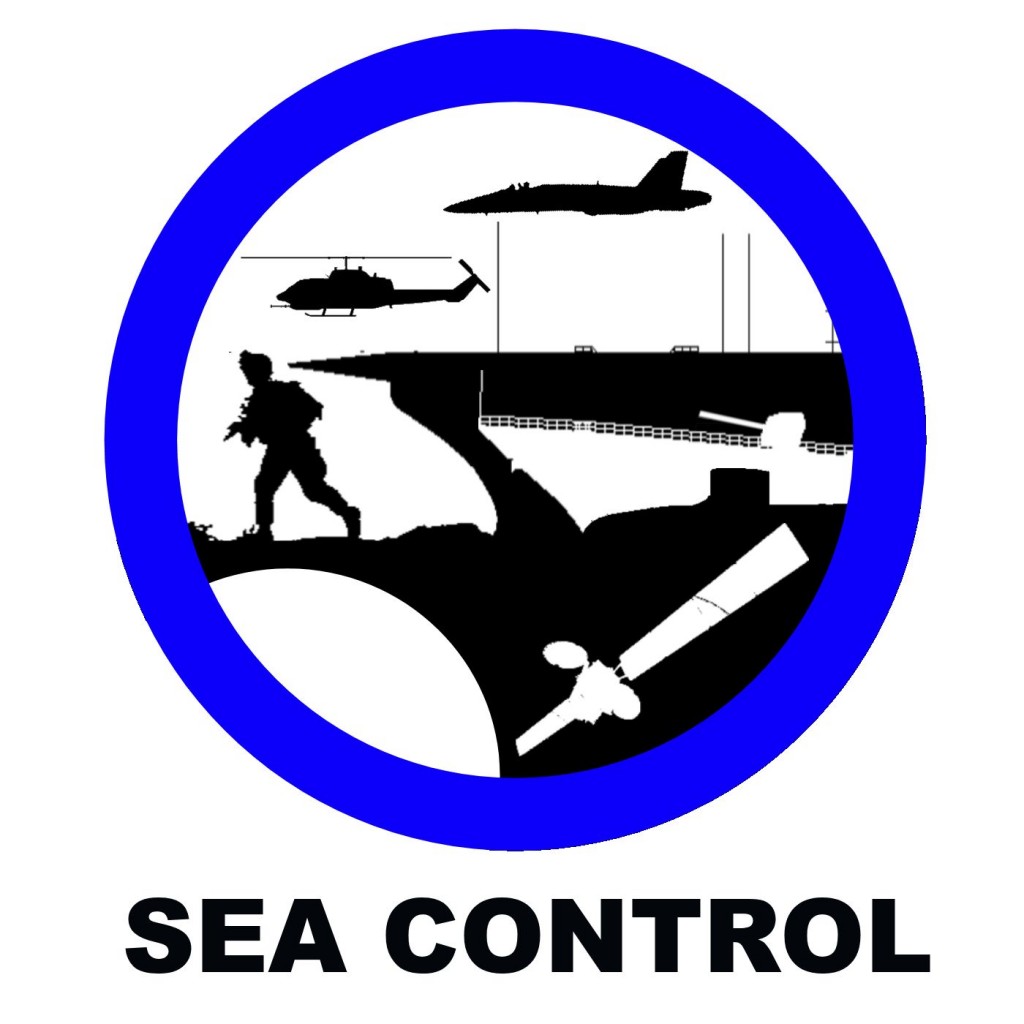 Matt and Chris wax on about the new budget deal and military benefits before finally discussing the incident between the Chinese and American navies, the Pacific balance, robotics, and books for the holidays. Remember to tell a friend and subscribe on Itunes or Stitcher Stream Radio. Leave a rating and a comment. Enjoy, Episode 13 of Sea Control, The Queen’s Shilling (download).
Matt and Chris wax on about the new budget deal and military benefits before finally discussing the incident between the Chinese and American navies, the Pacific balance, robotics, and books for the holidays. Remember to tell a friend and subscribe on Itunes or Stitcher Stream Radio. Leave a rating and a comment. Enjoy, Episode 13 of Sea Control, The Queen’s Shilling (download).
Category Archives: Future Tech
What is coming down the pipe in naval and maritime technology?
The Long Range Strike Bomber (LRS-B): Putting the Air in Air-Sea Battle
The Long Range Strike Bomber (LRS-B), also known as the Next Generation Bomber, is a developmental program aimed at producing a bomber[1] that will replace the current United States Air Force (USAF) B-1 and B-2 bomber fleet by the mid-2020s. [2]
As the United States Armed Forces reduces its Counter Insurgency (COIN) and nation-building operations and pivots towards the Pacific, it will increasingly require the ability to engage in state-to-state conflict. Unlike COIN operations, missions flown against nation states require the ability to penetrate enemy airspace without detection, requiring both stealth and the ability to travel long distances without aerial refueling. The rise of Anti-Access/Area Denial (A2/AD) capabilities by potential adversaries and the limited combat radius of fifth generation aircraft will put our ability to project force via air strikes at risk. The United States strategy cannot rely on a handful of aging B-2 Spirit Stealth Bombers whose ability to evade enemy radar is no longer a certainty.[3] Therefore, the DOD must develop a multi-role stealth aircraft based on existing technologies while using lessons learned from the F-35 development to minimize costs. If properly developed, the LRS-B will not only drop lead on target, but also serve a variety of stealth roles that would fully complement the future systems of all four branches of service.
The Current United States Bomber Fleet
As of December 2013, the United States Bomber Fleet is composed of approximately twenty B-2 Spirit “stealth” heavy bombers, seventy-six B-52 heavy bombers and sixty-six B-1B Lancer heavy bombers.[4]
The B-52 Stratofortress
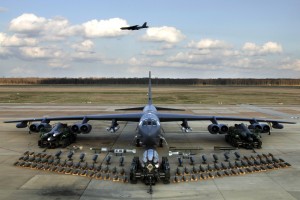
The B-52 is a highly versatile multi-role bomber which can perform strategic bombing, nuclear strikes, close air support (CAS), interdiction and other operations which include anti-ship and mine laying missions. Its versatility derives from the wide variety of weapons that it is able to carry, through both an internal bay and external hard points. It has been the primary U.S. heavy bomber since the 1960s and was the cornerstone of the air arm of the U.S. Military nuclear triad. As technology advanced, the B-52 was adapted to carry up to twenty air launched conventional and nuclear cruise missiles whose ranges vary between 690 and over 2000 miles depending on the type of missile employed. This upgrade maximizes the range of the B-52 (8,800 miles, 4,400 combat radius) while maintaining a safe standoff distance from enemy air defenses. Five B-52s could deploy upwards of 100 AGM-86C/D Conventional Air- Launched Cruise Missiles (CALCM) simultaneously. [5] Due to its large radar signature, it requires a significant amount of Suppression of Enemy Air Defense (SEAD) missions prior to it entering the battle space. [6] According to US Air Force roadmaps, the B-52 will remain in service until 2040 or until the replacement is fielded. [7]
The B1B Lancer
The B1 Bomber program was the third attempt to create a high-speed long-range nuclear bomber that would replace the effective, yet vulnerable, B52. The first two attempts, the B-58 Hustler and the XB-70 Valkyrie, could reach Mach 2 and Mach 3 respectively and outrun Soviet interceptor aircraft enroute to delivering their nuclear payloads. Soviet technical advancements thwarted both projects.
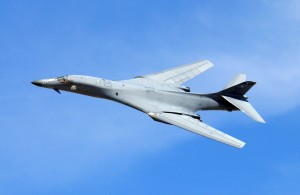
The development of high altitude Surface to Air Missiles (SAMs) rendered the B-58 obsolete and forced it into a low-level penetrator role. [8] Designed for high speed-high altitude flight, the B-58 failed at low altitudes. The B1A succeeded where the B-58 failed. By utilizing variable wing technology and terrain mapping radar, it is able to efficiently travel long distances then utilize its supersonic dash to penetrate enemy air space at low levels below enemy radar and SAM coverage. However, like most innovations in the cold war, it soon rendered obsolete thanks to another technological advancement, Look Down/Shoot Down Radar.[9] In light of this development, the DOD cancelled the B1A in 1977. Political pressure restarted the program by in 1980. The DOD decided the B1B would take over the heavy bomber role for the B-52 while the USAF transitioned to the B-2 Spirit.[10]
This “transitional” aircraft has endured to become the workhorse of the war on terror, dropping 60% of all ordnance in Afghanistan. Despite flying 1% of the combat missions in Iraq, it dropped 43% of all the Joint Defense Attack Munitions (JDAM) used in theatre. Loitering over the battlefield, the B1B can travel anywhere in Afghanistan in 45 minutes in order to support ground troops carrying 48 JDAMs, all capable of being accurately delivered on target. The B1B is integral to the Air-Sea battle concept for the Pacific Theatre, having the capacity to travel long distances and use up to 24 Joint Air to Surface Stand Off Missiles (JASSM) against enemy targets. [11] Despite its combat record, the B-1B is beginning to show its age, with each plane having to spend 48.4 hours in the repair shop for every hour it is in the air. Furthermore, each hour in the air costs $60,000 in fuel, maintenance and other costs.[12]
The B2 Spirit
The B-2 Spirit “stealth” bomber is the only bomber in the U.S. arsenal that is still capable of penetrating enemy airspace without the need for prior SEAD missions. Originally designed to drop unguided munitions, the advent of the JDAM now greatly multiplies the B-2’s combat effectiveness. During Operation Odyssey Dawn over Libya, three B-2s eliminated 45 targets in a single mission. [13]

In the 1980s, the USAF anticipated the number of B-2’s in the USAF would number close to 100 and it would be the primary strategic bomber in the U.S. arsenal, replacing the B-52 and its stopgap replacement, the B-1B. The shifting requirements of the end of the cold war, combined with a price tag of nearly two billion per plane, reduced this number to 20, a fifth of the original estimate. [14]
The large price tag of the B-2, F-22, and F-35 highlights the problems inherent in the USAF procurement process.[15] The cost of these stealth programs, albeit high, has provided the USAF with the technologies to develop the LRS-B at a significantly lower cost. The B-2 program, despite its costs, has been a success and remains our only stealth heavy bomber.
Limited Options
The U.S. policy makers originally set the target date for the LRS-B at 2018, however that date is no longer feasible.[16] The 1999 USAF roadmap planned to continue with the current fleet until 2037; however, the nation can no longer afford to delay the development of a modern and robust deep strike large payload aircraft.[17] As currently composed, the current U.S. bomber fleet cannot meet the challenges of the 21st century. When faced with the need to engage another nation, this aged fleet leaves war planners limited options:
- Launch cruise missiles from a standoff distance
- Risk sending B-2 bombers into enemy airspace, with each aircraft lost reducing the total number of B-2s in the U.S. Fleet by 5%.
- Utilize the above two options in conjunction with a larger SEAD effort
An attack against a nation with five buried and hardened nuclear facilities would require employing the GBU-57 Passive Ordnance Penetrator (MOP) to destroy them. Dropping four MOPs per target would involve risking half the entire B-2 fleet to accomplish the mission.[18] As a nation, the U.S. cannot afford to rely on such a small number of aircraft to execute U.S. policy. The B-2 has never flown a daytime mission due to its size and observeability, limiting enemy airspace penetration to a predictable 12 hours per day. [19] Since its inception, the United States has enjoyed the ability to penetrate any nation’s air defenses at any time with this remarkable weapon. Unfortunately, as SAM capabilities continue to improve, the B-2’s survivability is no longer a certainty.
The Evolving Threat of Air Defense Networks
The USAF 1999 Roadmap which assessed the B-1B, B-2 and B-52 bombers were sufficient to meet the strategic requirements of the U.S. until 2037 was based upon the enviable position in which the U.S. and its allies found itself in the 1990s.[20] The B-1B and B-2 aircraft, designed to penetrate the Soviet Union, entered service amidst the crumbling of their intended adversary. The USSR was the only non-allied nation capable of developing and manufacturing Integrated Air Defense Systems (IADS) and modern SAMs. IADS links various radars and early warning systems with SAM missile emplacements to a command and control station that detects tracks and intercepts enemy aircraft.[21] Previous SAM systems relied on a single radar array linked to a missile battery. IADS incorporates numerous elements that eliminate a single point of failure. Advanced American SEAD missions overwhelmed the IADS fielded by former Soviet client states such as Iraq and Serbia, however not without losses. The destruction of an F-117 by Serbian SAMs exposed its stealth limitations.
Russia, despite struggling to stabilize and adapt to a new political and economic system in the 1990s, continued to upgrade IADS systems needed to intercept U.S. combat aircraft.[22]The S-300 system, originally fielded in the late 1970s, is highly mobile and effective against targets at most altitudes due to constant upgrades. The system can be deployed quickly, and is designed to “shoot and scoot,” making it elusive to cruise missiles whose long flight time prevent it from hitting mobile targets without updated target data. All U.S. Aircraft, to include the F-35, are vulnerable to the S-300V/VM with the exception of the F-22 Raptor. [23]
China’s IADS budget is a fraction of the United States and its air defense and interceptor aircraft capabilities have lagged behind Russia and the U.S. for years. Based on recent assessments, China lacks a linked nationwide IADS. However, by using commercial technology to augment and upgrade its air defense infrastructure, China is at a pace equal to the development of commercial electronics. This use of commercial technology frees China from investing in long term and complicated military systems that are less flexible than the free market.[24] A comparison of Google Earth and Garmen GPS systems to the U.S. Army’s Falconview and Blue Force Tracker, respectively, is an example of this problem. China, using the S-300 as well as other SAM systems, has incorporated mobile launchers as well as ambush tactics to augment its fixed SAM sites and render its airspace inaccessible to the majority of US aircraft. [25]
Air-Sea Battle: Achieving American Power Projection in the Pacific
The emerging Air-Sea Battle strategy is counters Anti Access Area Denial (A2/AD) measures by utilizing various joint capabilities to penetrate enemy territory. In order to execute this strategy, the Navy and the Air Force will train, equip and organize their forces to seamlessly work in tandem to ensure the U.S. maintains operational access to the entire Pacific Rim. Air-Sea Battle is being developed to counter the increasing A2/AD capabilities of some nations in the western Pacific, such as China.
These A2/AD capabilities prevent a carrier battle group (CBG) from approaching within, at a minimum, 1200 Miles from the coast, which is the half the alleged maximum range of the Chinese HN 2000 Surface to Surface (SSM) Low Altitude Cruise Missile (LACM). A variant of the DH-10, the HN 2000 is still in development but it on the horizon. Following the DH-10 variant, China has the CSS-5C Medium Range Ballistic Missile (MRBM) , CSS-5D (Anti-Ship Ballistic Missile), CSS-6 Short Range Ballistic Missile (SRBM) and the CSS-7 (SRBM). The CSS-5D ASBM, also known as the DF-21D, it the world‘s first ASBM. The CSS-5D launches into the upper atmosphere and releases one or more reentry warheads that descend on the target from directly above. The speed of the warhead and attack angle makes it impervious to standard anti-missile missiles and to the Close in Weapons System (CWSS) or the RIM-116.[26] Granted the ability of this weapon system to accurately adjust its trajectory during terminal guidance is unknown. However, the potential threat of these missiles may be great enough to prevent war planners from risking a Gerald Ford Class aircraft carrier, whose price tag is greater than the yearly military expenditure of 136 nations, including Spain and Columbia.
The range of these anti-ship missiles denies not only the entry of a CBG into the South China Sea, but prevents the CBG’s aviation element from getting within range. This is due to the combat radius of the F-35C and F-18 E/F being 707 miles and 449 Miles respectively. In order to attack mainland China using carrier strike aircraft, refueling aircraft must be stationed 250 miles from land to avoid the S-300 IADS, thereby requiring refueling missions both inbound and outbound of any strike mission. Air Force and Marine Corps Aircraft operating out of Japan and Korea could augment a long-range naval air strike force, utilizing F-18 E/F Super hornets, F-15 D Eagles and F-15E Strike Eagles as well as any F-35A/B’s or forward deployed F-22’s. The strike aircraft will be limited in the amount of air to surface missiles that they can carry, reducing the overall effectiveness of the strike.
In light of China’s A2/AD missile perimeter, war planners have limited options. If they do not want the risks associated with a traditional SEAD penetration airstrike, only standoff attacks would remain an option.
One possible method of a standoff attack is the employment of converted Ohio Class SSGN Cruise Missile Submarines, which are capable of carrying up to 154 Submarine Launched Cruise Misses (SLCM). The SSGN’s would approach by stealth and shower IADS, SAM, and SSM emplacements with cruise missiles to pave the way for naval forces and follow-up strikes by air assets. However, this capability suffers from the same numeric limitations as the B-2 Spirit. There are only four SSGNs currently in service, and are scheduled to be replaced by upgraded Virginia Class Submarines between 2023 and 2026. [27] The loss of one SSGN would result in a 25% reduction in the overall force. A second option is also a large cruise missile assault, albeit launched from the air. B-52, B-1 and B-2 aircraft would launch cruise missiles from a standoff distance of at least 250 miles with a similar target package as the SSGNs. The two options can be used in tandem, but require on-station surveillance to perform Battle Damage Assessments (BDA) and track the mobile SSMs and other IADSs.
Limitations of Cruise Missiles
Cruise Missile strikes from a standoff distance has three primary vulnerabilities.
1. Cruise missiles are equally vulnerable to enemy air defenses as U.S combat aircraft. Enemy Radar will be able to detect and track the first wave of inbound cruise missiles. Once detected, a cruise missile is vulnerable to SAM interception and can be tracked and destroyed by air-to-air missiles.
2. The majority of Chinese SSM, IADS and SAM equipment are mobile, allowing them to redeploy rapidly. The cruise missiles will strike the original target area without real-time target updates.
3. Fixed targets, such as large radar arrays, command and controls bunkers and airfields will be hardened and may require multiple strikes as the payload of a cruise missile its minimal due for its need to carry fuel and guidance systems. Thus to compensate for the relatively small warheads found on conventional cruise missiles, adversaries could simply harden their high value assets. Furthermore, conventional cruise missiles cannot destroy heavily reinforced bunkers thus requiring the GBU-57 Massive Ordinance Penetrator (MOP).
The employment of this bomb requires heavy bomber presence over the target area. This requirement, due to the stealth limitations of our bomber force, will require SEAD activities prior to their going “feet dry” over the mainland. This requirement runs counter to the purpose of striking fixed positions, which is to blind the enemy and to eliminate command and communication elements. The LRS-B will be able to carry 5,000-pound GBU-28’s as well as the MOP.
One of the critical roles which the LRS-B will perform is Command, Control, Communications, Computers, Intelligence, Surveillance and Reconnaissance (C4ISR). The current USAF and USN C4ISR systems are currently not organic to any strike aircraft other than the existing and vulnerable bomber fleet. The USN will continue to develop C4ISR assets that are stand-alone platforms.[28] When conducting blue water fleet operations, such platforms are ideal. However, when operating in enemy air space, these systems will be vulnerable to Electronic Counter Measures (ECM), SAMs, and may require fighter escort, further risking its detection in the battle space. A stealth LRS-B would be combine C4ISR functions with its other capabilities. One such capability is the ability to find, fix and finish. The LRS-B could illuminate targets for other aircraft, perform BDA and conduct immediate follow-up strikes on remaining and partially destroyed targets with its large array of armaments.
Required Capabilities
The goal of the LRS-B Program is to create an airframe that combines the capabilities of the B-1 and B-2 utilizing existing technologies that is updates easily. In order to fulfill its future role as a stealthy long-range strategic bomber, the LRS-B must meet or exceed the following criterion:
• Crew: 4
• Low Observable/ Stealth Capability
• Cyber Warfare Capable
• C4IRS and advanced targeting capabilities
• Able to network with equipment from all service branches
• Avionics
o Full suite of Air to Air, Air to Ground offensive phased-array radar.
o Extensive jamming and radar warning equipment
o Internal targeting equipment capable of guiding USN and USAF ordinance.
• Armament
o 2 rotary launcher mounted multiple ejector racks
o Able to carry all weapons systems of the B-1 and B-2 to include the planned Long Range Stand Off Cruise Missile
o AIM-120D Air to Air Missile
o B61-12, B83 Nuclear weapons
• Performance
o Service ceiling of 60,000 ft.
o Combat Radius of 4,000 miles
o Fuel efficient engines which allow for a maximum loiter time over the AO as well Supersonic Dash capability of Mach 1.25
o Capable of Daytime Operations
The Multirole Potential of the LRS-B
The LRS-B will be a multirole aircraft that fills critical gaps in capabilities of every branch of service based on two principles that our military currently lacks: The ability to penetrate and persist over enemy airspace and the ability to remain invisible to IADS.
The Missileer
In the late 1950’s, the U.S. Navy conceived of a fleet defense fighter with limited maneuverability. Douglas aircraft was awarded the contract and began development of the F6D Missileer. This plane was designed to loiter over the Carrier Battle Group for long periods while using its powerful radar and long range air-to-air missiles to intercept incoming enemy aircraft.[29] The concept, developed simultaneously with the F-4 Phantom, represented the popular mindset of the obsolescence of dog fighting due to the development of long-range air-to-air missiles. To this point, the F-4 Phantom was fielded as the primary aircraft for three branches of service without an internal cannon! As we know from literature on the topic (or by watching Top Gun), this concept was discarded following the experiences of the USAF, USMC and USN over the skies of Vietnam. The missile development portion of the missileer program did not fail, as it bore the long range AIM-54 Phoenix and the AIM-120 AMRAAM.
The F6D concept was a 20th Century failure that could easily be a success in the networked military of the 21st century. As part of the Air-Sea Battle Concept, the LRS-B could act as a large missile platform working in concert with the F-22 and F35. Both smaller aircraft have limited internal bay capability and limited range. Upon confronting enemy air defenses during interdiction and anti-fleet operations, the smaller aircraft could act as spotters while a LRS-B defeats the initial wave of interceptors with air-to-air missiles, allowing the F-35 and F-22s to retain their weapons and carry a larger amount of strike weaponry. While such an arrangement is not ideal, the LRS-B should at least have such a capability in order to give future war fighters the maximum amount of tactical options. Given the distances involved, redundant capabilities are essential in the event of a conflict which produces heavy losses of naval and aerial weapons platforms.
Airborne Refueling
If current budgetary trends continue, it will force the U.S. Military to reduce its bases overseas. Even with the current worldwide base structure, airborne refueling operations are essential to almost every significant air operation. Fifth generation aircraft such as the JSF and F-22 lose their stealth capability when burdened with external drop tanks. Given that our current air-borne refueling aircraft, the MC-130P/J and KC-135, is highly vulnerable, the concept of a modified LRS-B acting as a tanker a necessary option. [30] [31]
Strike Capability/Air Defense
The primary mission of the LRS-B is air-space penetration. It will also retain the abilities of the current bomber force to launch standoff attacks with cruise missiles. A LRS-B designed with an organic air-to-air capability, will be able to defend the vulnerable bomber fleet during standoff attacks. In this role, a Bomber Wing can act independently, freeing up air superiority aircraft for other missions
SEAD/Electronic Warfare/Cyber
Utilizing its stealth capability, the LRS-B will be able to travel unmolested over the battlefield. By using electronic warfare, cyber-attacks and conventional anti-radiation weaponry, the LRS-B will wreak havoc on an enemy’s air defense network. When used in conjunction with non-stealth aircraft on the perimeter of radar coverage, war planners can further deceive an enemy to the true origin of the attack. This variant of the LRS-B would also replace/augment the propeller driven EC-130H electronic warfare aircraft. [32]
Unmanned Capability
The capability may exist for the LRS-B to operate unmanned. Given the current budgetary environment and lack of risk associated with using unmanned vehicles, this capability could tempt future policymakers to choose expedience over reason.[33] An unmanned bomber carrying nuclear ordinance eliminates the human element in the direct release of nuclear weapons. Furthermore, no amount of automation or electronics can substitute for having seasoned pilots at the helm of our most potent aircraft in combat conditions.
The F-4/F-35 of Bombers?
To be clear, one aircraft does not have to fill the aforementioned potential roles of the LRS-B. The fact that the LRS-B is a bomber means the design will require a large internal space in which to carry payload. This large space allows the bomber to be modified, with other items being placed within the confines of the airframe. The F-35, by contrast, was designed around the need of one of its versions to have a SVOTL capability.
The LRS-B is a tremendous opportunity to field a large fleet of Stealth Aircraft to replace airframes that were being developed and fielded during the Cold War. The offensive capability of the United States has always served as the backstop for U.S. Foreign Policy, with our adversaries ever conscious of the U.S. Military’s innate ability to project force on land, air and sea. If the LRS-B is rendered a casualty to budget cuts, it will weaken our ability to respond to potential aggressors, limit our ability to strike an enemy in his own backyard and will ensure our aging bomber fleet will eventually be rendered obsolete.
Robert Hodge is a U.S. Army veteran and graduate student at George Washington University in Washington, D.C.
[1] Carlo Munoz, DoD Fast Tracks New Bomber; ‘Planning Number is $550 Million Per Plane, http://defense.aol.com/2012/02/15/dod-fast-tracks-new-bomber-planning-number-is-550-million-pe/, (February 2012).
[2] Sanda Erwin, “New Stealth Bomber Can’t Be Another B-2,” National Defense 96.700 (Mar 2012): 8.
[3] David Hambling and Becky Ferreira, “Invisible Warriors,” Popular Science 280.1 (Jan 2012), pg 50
[4] United States Air Force Factsheets; http://www.af.mil/AboutUs/FactSheets/tabid/131/Indextitle/B/Default.aspx
[5] United States Air Force Factsheets; http://www.af.mil/AboutUs/FactSheets/Display/tabid/224/Article/104465/b-52-stratofortress.aspx
[6] “Air Force faces tough decisions on aging fleet,” 24 March 2013, Dayton Daily News, Main; Pg. A1
[7] Adam J. Herbert, “Great Expectations,” Air Force Magazine, Vol. 90, No. 8 (Aug. 2007),
[8] Bill Gunston and Mike Spick, Modern Air Combat, (New York: Crescent Books, 1983), pg 132
[9] Bill Gunston and Mike Spick, Modern Air Combat, (New York: Crescent Books, 1983), pg 41.
[10] “Air Force Activates B1B Bomber Unit,” The Washington Post, 2 October 1986, pg. A17.
[11] “B-1B bomber mission shifts from Afghanistan to China, Pacific,” USA Today, 8 July 2012
[12] “The Air Force Needs a Serious Upgrade,” The Wall Street Journal, 15 July 2010, Opinion.
[13] John Tirpak, “Bombers over Libya,” Air Force Magazine (July 2011), Vol. 94, No. 7.
[14] David Axe, “Why can’t the Air Force Build an Affordable Plane?” The Atlantic (March 2012).
[15] Sanda Erwin, “New Stealth Bomber Can’t Be Another B-2,” National Defense 96.700 (Mar 2012): 8.
[16] Tech. Sgt. Russell Wicke, “Gen Moseley: New long-range bomber on horizon for 2018,” U.S. Department of Defense Information / FIND (26 July 2006).
[17] Hearing before the Military Procurement Subcommittee, Performance of the B-2 Bomber in the Kosovo Air Campaign, H.A.S.C. No. 106-24, U.S. Government Printing Office, Washington: 1999, pg. 48-50
[18] Brooks McKinney, Northrop Grumman Begins Work to Equip B-2 Bomber with Massive Penetrator Weapon, http://www.irconnect.com/noc/press/pages/news_releases.html?d=123187 (July 2007).
[19] Barry Watts, The Case for Long Range Strike: 21stCentury Scenarios, Center for Strategic and Budgetary Assessments, www.CSBAonline.org (December 2008).
[20] John Tirpak, “The Bomber Roadmap,” Air Force Magazine Vol. 82, No. 6.
[21] NATO Integrated Air and Missile Defense, http://www.nato.int/cps/en/natolive/topics_8206.htm
[22] Carlo Kopp, “Surviving the Modern Integrated Air Defense System,” Air Power Australia Analysis 2009-02 (Feb. 2002).
[23] Carlo Kopp, “Self Propelled Air Defense System/SA-12/SA-23 Giant/ Gladiator,” Technical Report APA-TR-2006-1202, http://www.ausairpower.net/APA-Giant-Gladiator.html#mozTocId650591
[24] Sharon Weinberger, China’s Off-the-Shelf Air Defense, http://www.wired.com/dangerroom/2008/01/chinas-off-the/ (January 2008).
[25] Roger Cliff..[et al], Shaking the Heavens and Spitting the Earth: Chinese Air Force Employment Concepts in the 21st Century (Santa Monica: RAND Corporation, 2011) Pg. 80-83 and appendix xxiv.
[26] Office of the Secretary of Defense, “Annual Report to Congress: Military Power of the People’s Republic of China, 2008, Pg. 30; http://www.defense.gov/pubs/pdfs/China_Military_Report_08.pdf.
[27] Cruise-missile submarines being phased out,” Kitsap Sun 8 February 2013. http://www.kitsapsun.com/news/2013/feb/08/cruise-missile-submarines-on-the-way-out/#axzz2SiisIChY
[28] Committee on C4ISR for Future Naval Strike Groups, National Research Council, C4ISR for Future Naval Strike Groups (Naval Studies Board, 2006).
[30]United States Air Force Factsheets; http://www.af.mil/AboutUs/FactSheets/Display/tabid/224/Article/104534/mc-130eh-combat-talon-iii.aspx
[31]United States Air Force Factsheets; http://www.af.mil/AboutUs/FactSheets/Display/tabid/224/Article/104524/kc-135-stratotanker.aspx
[32]United States Air Force Factsheets; http://www.af.mil/AboutUs/FactSheets/Display/tabid/224/Article/104550/ec-130h-compass-call.aspx
[33] “The Air Force’s simple, no-frills, advanced new bomber” DOD Buzz, 13 February 2012, http://www.dodbuzz.com/2012/02/13/the-air-forces-simple-no-frills-advanced-new-bomber/
Non-Traditional Drone Motherships
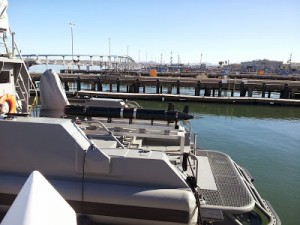
Earlier this week, guest blogger Mark Tempest posted some interesting ideas on low cost alternatives to traditional combatants that could be configured to carry unmanned surface vehicles, playing on the idea that payload truly is more important than platform. These concepts are unorthodox, though as Mark points out, not unprecedented. In a time of shrinking budgets and smaller fleets, the navy should explore how to optimize various combinations of ships and the unmanned vehicles they will carry, with an eye towards both effectiveness and efficiency. Mine counter-measures is an important, though often short-changed mission, with various trade-offs between payload and platform.
Between the Littoral Combat Ship “seaframe” and mission modules, the U.S. Navy has invested billions of dollars in R&D and acquisition money to develop (though still not fully) the capability to conduct off-board, unmanned mine counter-measures. LCS will carry the Remote Minehunting System, a rather large, complex, diesel-powered snorkeling vehicle which has been under development for about two decades. RMS is designed to tow a side scan sonar in order to detect mines. Contrast that arrangement with the Coastal Command Boat, pictured here with an embarked Kingfish, an unmanned underwater vehicle which essentially performs the same job as the RMS with its synthetic aperture sonar. The CCB, or the follow-on MK VI patrol boat can carry two of these UUVs. A well deck equipped amphibious ship (LPD, LSD, LHD) could be configured to carry multiple MK VIs, resulting in the ability to rapidly deploy several UUVs over a wide area at any given time. Additionally these patrol boats, or as Mark suggests, another Craft of Opportunity, could be forward deployed or prepositioned in various overseas ports, including ones too small or too politically sensitive to station a larger combatant. An LCS can bring an MCM capability to a mine field at 40 knots, much more rapidly than dedicated MCM ship. A C-17 with patrol boats and a UUV Det can transport MCM package at 10 times that fast. Certainly there are other trade-offs in capability, cost, and versatility in all these options.
Given these emerging MCM alternatives, future fleet experimentation to identify other payload/platform configurations that can achieve the same operational results as the LCS/RMS package in a more affordable manner is certainly warranted. Because of the relatively low cost involved in these platforms and UUVs, the answer doesn’t have to be all or none and more than one alternative can be pursued without breaking the bank.
This article was re-posted by permission from, and appeared in its original form at NavalDrones.com.
Drone Pilots: Statistically, On the Front Lines
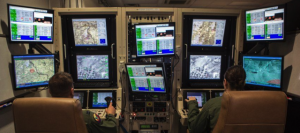
- The battlefield is not the only place our defenders die.
Within the Air Force, there is no cow more sacred, no shibboleth greater, than the glory that is the manned fixed-wing combat aircraft. While even the most obstinate fighter pilot might be willing to concede that unmanned aircraft will necessarily make up the majority of a future force, such pallid (even bloodless) prospects are loudly lamented. Valor and heroism cannot be had from an armchair; Sic transit gloria Air Force.
Within the Air Force, it is the danger and thrill of piloting (and the concomitant safety and tedium of remote combat) that justifies the continued marginalization of the RPA community from promotions and awards. Certainly, flying RPA is less exciting than flying a F-18. But, as a career, is it actually that much less dangerous?
It’s not hard to imagine, early one morning, an IED going off on the road to Creech AFB, blowing up a commuter bus full of RPA pilots on their way to work. How different would the conversation about a “drone medal” have been in the wake of significant combat casualties? Such a scenario isn’t just possible – it’s one America’s enemies are actively trying to bring about.
Critics might say that this is just a hypothetical, which is true. It’s exactly as hypothetical as a fast-mover being brought down by enemy fire in post-invasion Iraq or Afghanistan, which is to say that it’s a possibility which has never occurred. For these two wars, “combat risk” has been as hypothetical for F-16 pilots in Iraq as for RPA pilots in Nevada. But even if we accept that fixed-wing combat aircraft are working in a very low risk combat environment in Iraq and Afghanistan, what about all the other dangers of flying? While, a differential risk analysis still supports the conclusion that flying RPA in combat is only marginally less dangerous than flying manned fixed-wing combat aircraft.
Now, I can almost hear the jaws of fighter jocks hitting the floor. How could armchair warfare approach the danger of conducting close air support over hostile territory? The answer is: cumulatively. Now, the Air Force should be more amenable to this line of thinking than the other branches of the armed services. During WW2, the Bronze Star was created to raise the morale of infantrymen who were disheartened by the Air Medal. As George Marshall said in a memo to Roosevelt, infantrymen “lead miserable lives of extreme discomfort and are the ones who must close in personal combat with the enemy.” And yet, this viewpoint mostly originates from a skewed view of what risk is. It’s true that your average WW2 infantryman faced individual moments of tremendous danger, punctuating long bouts of boredom. Given the personal courage required to maintain effectiveness in the face of the enemy, it is easy to see why infantrymen could be dispirited by medals going to bombardiers flying safely miles above the battlefield. But, while the risk of any particular bombing mission was relatively low (over Germany, about 5%), it was the cumulative risk that was so valorous – only one crewman in six was expected to survive his tour intact. The courage of the infantryman consisted in doing an exceptionally dangerous thing a few times; the courage of a bombardier, in doing a mildly dangerous thing many times.
If the modern student of war can understand why the infantryman’s courage cannot be privileged over the air crewman’s, he can come to see why the manned pilot’s valor cannot be preferred to the unmanned, in both the current wars and the wars to come. First, combat looks very different in asymmetrical wars like Iraq and Afghanistan. In twelve years of combat, we’ve lost a whopping one fighter jet to hostile fires in the air, in 2003. In both wars, we’ve lost a total of 18 fixed-wing fighter aircraft (almost all due to human errors or mechanical failure), and six of those pilots have died. Although each of these deaths is tragic, six fatalities in two wars over twelve years is hardly an epidemic, and these deaths account for a tiny fraction of all airmen who have died over these twelve years.[1] Moreover, only one of these deaths was caused by enemy fire, largely due to the fact that, since 2003, the enemy has had zero capability to shoot down fast-movers. From a statistical standpoint, since the defeat of Saddam’s air defense weaponry, ~0% of the risk to manned fixed-wing combat aircraft has come from enemy fires – all of the risk is due to the general risks associated with flying. This is not to say that flying is not dangerous – over the past ten years, there have been an average of 8.2 fatalities a year (though most of those fatalities come from multi-death incidents). But for fast-movers in particular, none of the risk comes from combat or deployment.
What then, are the primary dangers to airmen? The data unequivocally says motor vehicle accidents (52 fatalities in 2012) and suicides (over 100 in 2011), [2] and on the rise) kill the most airmen every year. Nor are these two kinds of casualties equally distributed across occupations. Because most of the data is hard to get at, the following are sketches of arguments, suggestive evidence open to empirical verification.
Ironically, one of the “perks” of being an RMA operator – not deploying and instead commuting to work every day – almost certainly will, over time, kill more operators than flying manned planes would. According to a NATO morale survey[3], a significant number of Reaper/Predator pilots complained about the long commutes to the bases where they work (meaning they had commutes of over an hour). Combined with high levels of work-related stress, long shifts for months on end, and unhealthy sleep schedules, this driving substantially raises the risk of a vehicular accident (though exactly how high, it’s difficult to say). Manned fixed-wing pilots have some of the same work issues as unmanned pilots, of course, except that they are deployed for months at the time when their occupational stress is the highest (and when they would have the highest work-induced risk factors for a vehicular accident). It’s a little counterintuitive, but when your main job (flying combat sorties) has become surprisingly safe, the risk starts to come from weird, other factors.
Now, I don’t mean to suggest a perfect equivalence between a pilot who dies in a car crash on his way to work and one who dies flying in an operation over Iraq (rare as that is). But risk analysis demands that we also take lots of small risks over time to be serious and meaningful. An airman fatigued from piloting a Predator for 12 hours straight who dies in a crash at 2am on his way home from Creech AFB has “paid the ultimate price” just as surely as a disoriented F-18 pilot who makes a fatal maneuver. And some of the risks from driving that airmen face are operational –they come from the pace and intensity of their work. [4]
While added driving risk is difficult to tease out, suicide provides a much more personal face to a 21st century understanding of what combat risk is. Our wars in Iraq and Afghanistan might be the first in history where the number of suicides exceeds the number of combat deaths. Because that the Air Force doesn’t publish casualty breakdowns by Air Force Specialty Code (though a FOIA request might dislodge them), it’s impossible to say what the suicide rate amongst only pilots has been. But we do know some things about it from other research.
Mostly, we know that the suicide rate amongst pilots (RPA and Manned) is lower than the rest of the Air Force; pilots are officers and are selected for physical, mental and moral capabilities, both of which reduce risk factors for suicide. But, of course, the risk factors for individual pilots vary depending on their circumstances. One of the biggest risk drivers of suicide for veterans is PTSD, which one study showed to make someone ten times more likely to successfully commit suicide.[5] And a number of recent studies have shown that RPA pilots are at an increased risk of PTSD and work-related stress. A NATO study found low morale and high levels of operationally-induced stress in Pred/Reaper crews.[6] More significantly, a retrospective cohort survey found that RPA pilots have higher levels of PTSD and other mental health diagnosis compared to manned pilots.[7] Absolutely, they face a 60% increased chance (in this admittedly limited survey) of a mental health issue, although adjustments for age and experience brought that number back towards the baseline.
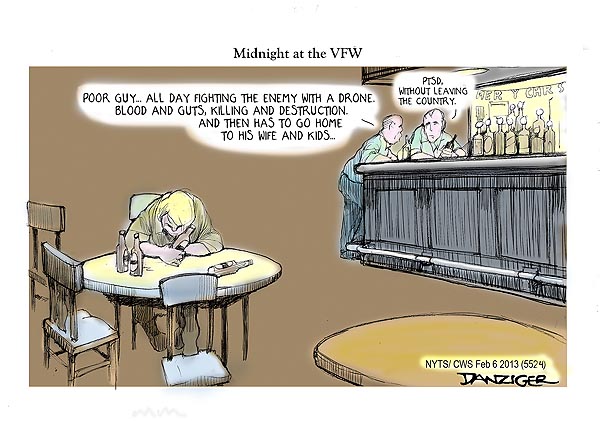 Unfortunately, despite a fairly extensive search of the data available online, it’s hard to drill down more on the number of suicides afflicting pilots. But it’s sort of irrelevant, because I can still lay out my basic conceptual case for a new way of thinking about risk. The case that being an RPA pilot isn’t much less dangerous than being a fighter pilot is pretty simple. In low-intensity conflicts like Iraq and Afghanistan, the hostile fires-risk part of a fighter pilot’s job approaches zero, leaving only the risk of flying (~1 Class A mishap/100k flight-hours). On the other hand, while a lot of the data is still coming in, we know that being an RPA pilot carries its own set of real, physical risks. The geographical placement of AFBs where RPA pilots work and the increased stress of their jobs takes a physical toll. Over time, those risks will add up to deaths. Given that, for fighter pilots in particular, the going fatality rate seems to only be about 1-2 per year, it is logical to conclude that the combination of increased motor vehicle risk and suicide risk could render RPA more dangerous than flying, over time. This hypothesis is empirically testable (albeit using data the Air Force hasn’t made available), and it may be worth following up on this post with further research.
Unfortunately, despite a fairly extensive search of the data available online, it’s hard to drill down more on the number of suicides afflicting pilots. But it’s sort of irrelevant, because I can still lay out my basic conceptual case for a new way of thinking about risk. The case that being an RPA pilot isn’t much less dangerous than being a fighter pilot is pretty simple. In low-intensity conflicts like Iraq and Afghanistan, the hostile fires-risk part of a fighter pilot’s job approaches zero, leaving only the risk of flying (~1 Class A mishap/100k flight-hours). On the other hand, while a lot of the data is still coming in, we know that being an RPA pilot carries its own set of real, physical risks. The geographical placement of AFBs where RPA pilots work and the increased stress of their jobs takes a physical toll. Over time, those risks will add up to deaths. Given that, for fighter pilots in particular, the going fatality rate seems to only be about 1-2 per year, it is logical to conclude that the combination of increased motor vehicle risk and suicide risk could render RPA more dangerous than flying, over time. This hypothesis is empirically testable (albeit using data the Air Force hasn’t made available), and it may be worth following up on this post with further research.
This analysis also makes a broader point. The Air Force has reached a point where heroism can no longer really be understood by amounts of physical risk. Though outside the scope of this post, enlisted AF technicians who deployed to Iraq and Afghanistan and whose duties took them outside the wire were manifestly more subject to combat risk than the pilots deployed to support OEF and OIF. We have been fighting wars where physical risk has not necessarily most heavily accumulated to those doing the actual killing (e.g. C-130s, not F-15s, are subject to hostile fire). What this reveals is something that was probably true all along. We need to stop idolizing risk and realize that we should make heroes who look like the excellences we need. The sacrifices that C-130, F-18, and MQ-9 pilots make to perform excellently and serve their country well are all going to look a little different. It’s long past time to stop privileging one view of heroism.
[1] Air Force Safety Center, 7 &d 19
[2] Many accidents are actually suicides. Cf. Pompili et al (2012), Car accidents as a method of suicide: a comprehensive overview, Forensic Sci Int.
[3] Psychological Health Screening of Remotely Piloted Aircraft (RPA) Operators and Supporting Units, 2011
[4] Combat exposure, too, has a role to play (http://www.journalofpsychiatricresearch.com/article/S0022-3956(08)00003-4/abstract).
[5] Gradus et al (2010), “Posttraumatic Stress Disorder and Completed Suicide”, Am J of Epidemiology.
[6] Psychological Health Screening of Remotely Piloted Aircraft (RPA) Operators and Supporting Units, 2011
[7] Otto et al (2013), “Mental Health Diagnoses and Counseling Among Pilots of Remotely Piloted Aircraft in the United States Air Force”, MSMR.

